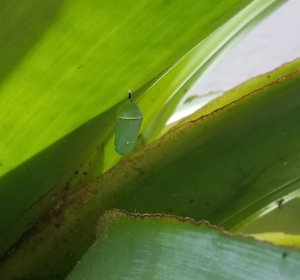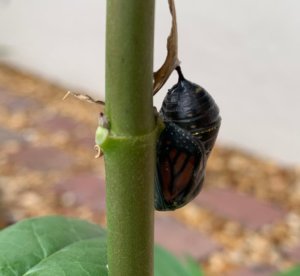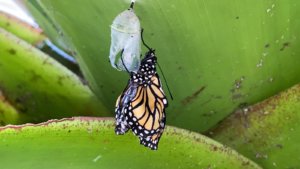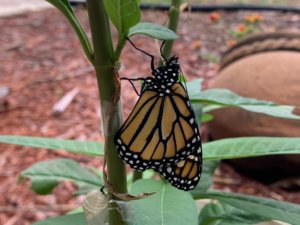I purchased two milkweed plants from a local nursery and I selected plants that had caterpillars on them. I got a hold of three caterpillars. I didn’t read about monarch caterpillars before buying the plant and I assumed they would eat and transform on the milkweed plant, especially since the next morning one had already formed its pupa on the plant. They were munching away on the plant. The next day, like I mentioned, one already molted into a chrysalis (AKA pupa), another had left and the other kept trying to leave the plant. I thought maybe the caterpillars got tired of eating from that milkweed. I moved the remaining caterpillar to another plant but I think a bird got it because it was too visible. When I googled why my caterpillar was trying to leave the milkweed plant I discovered that they do not like to form their chrysalis on the milkweed and will travel to another plant.
By my surprise and by accident, I found the lost caterpillar under one of the leaves of my imperial bromeliad which was about 10 feet away from the milkweed plant. The caterpillar had traveled quite a way and made it to a top leaf so it can molt. I found the caterpillar attached by the tip hanging head down in a J shape. This is what they do when they are ready to become a pupa. Prior to their molt they will stop eating, lay down some silk and will stay hanging head down for around 24 hours. Shortly before its final molt the caterpillar will straighten some and the antennae will become ragged, they will then split their old skin and wiggle out. Out of pure luck and good timing, I was able to witness first hand how it transformed and formed the pupa.
 When I found the caterpillar hanging I noticed the head was already green and rapidly it started to cover its entire body. I observed how its skin was pushed up. I thought it would take longer and took a video of the beginning, I stopped and then I realized it was happening really fast, and got a shot of the end. To my surprise the transformation took about 4 minutes for the caterpillar to complete the pupa. Unfortunately I did not film the entire process but I did see it. It is truly amazing! Here are two videos of the pupa starting to form and the pupa completing its formation that I captured. The pupa remains green for about 1-2 weeks, and about 24 hours before the monarch butterfly is ready to emerge, the pupa will begin to darken and become transparent. I read that when the butterfly emerges nothing should touch its wings since the butterfly will need to pump the wings full of fluids and then dry them and if touched it can disrupt the process.
When I found the caterpillar hanging I noticed the head was already green and rapidly it started to cover its entire body. I observed how its skin was pushed up. I thought it would take longer and took a video of the beginning, I stopped and then I realized it was happening really fast, and got a shot of the end. To my surprise the transformation took about 4 minutes for the caterpillar to complete the pupa. Unfortunately I did not film the entire process but I did see it. It is truly amazing! Here are two videos of the pupa starting to form and the pupa completing its formation that I captured. The pupa remains green for about 1-2 weeks, and about 24 hours before the monarch butterfly is ready to emerge, the pupa will begin to darken and become transparent. I read that when the butterfly emerges nothing should touch its wings since the butterfly will need to pump the wings full of fluids and then dry them and if touched it can disrupt the process.
Ten days after the caterpillar formed the pupa it turned transparent and I was able to see the wings. I did not get to see it come out of the pupa but I did get to see the butterfly. It stood on the plant for about two hours until it took flight. It was a true blessing to see the entire life cycle!




